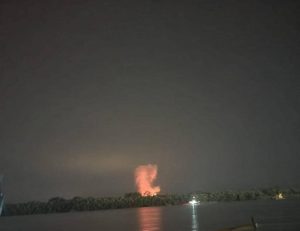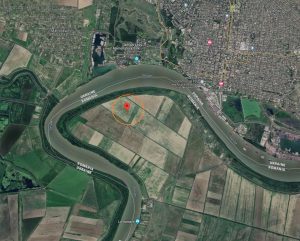In a regional context tense with the proximity of war, a new episode has raised questions about the security of countries bordering Ukraine. On September 4, Russian drones fell on Romanian territory, an episode described by the local media as “the most serious security problem” since the start of Russia’s invasion of Ukraine.
 Already, in November 2022, a missile fell on the territory of a NATO country, in this case in Poland, 8km from the Ukrainian border, killing two people. Initially attributed to Russia, the missile was later identified as coming from Ukrainian air defense, leading Warsaw to refer to an “unfortunate incident” and to play down the situation.
Already, in November 2022, a missile fell on the territory of a NATO country, in this case in Poland, 8km from the Ukrainian border, killing two people. Initially attributed to Russia, the missile was later identified as coming from Ukrainian air defense, leading Warsaw to refer to an “unfortunate incident” and to play down the situation.
Chronology of a controversy
On Monday, September 4, 2023, Ukrainian Foreign Ministry spokesman Oleg Nikolenko posted a photograph on Facebook that would have captured the moment when a Russian drone, launched on the night of September 3 to 4 towards the port of Ismail in Ukraine, fell and exploded on Romanian territory.
Initially, this information was categorically denied by Bucharest: “At no time did the means of attack used by the Russian Federation generate direct military threats against Romania’s national territory or territorial waters,” stated a press release from the Romanian Ministry of Defense. Defense Minister Angel Tîlvăr stressed that “we are present with all the capabilities intended to warn and monitor the situation in the region, which is why the information we provide is accurate and correct from all points of view.” President Klaus Iohannis also affirmed that no Russian drone parts had fallen in Romania.
Then, on September 6, Minister Tîlvăr backtracked on his statements of the previous day, saying that objects that could be associated with drone-type equipment had been identified on Romanian territory and that technical checks were needed to determine their exact origin. However, Bucharest officials are reluctant to make statements that could inflame tensions: “We have to distinguish between an incident and an act of aggression. (...) I have no reason to believe that this was an act of aggression. Romania and the Alliance are not in a situation where NATO space is under attack”, said the Defense Minister. This view is also shared by former Romanian Foreign Minister Cristian Diaconescu, who believes that state institutions must clarify the analogy between incidents and deliberate aggression. Similarly, NATO Secretary General Jens Stoltenberg declared on September 7 that NATO had no proof that the drone debris found in Romania was the result of a deliberate attack by Moscow. However, “if confirmed that these elements came from a Russian drone, such a situation would be inadmissible and constitute a serious violation of the sovereignty and territorial integrity of Romania, a NATO ally.” On the same day, the Ukrainian President’s reaction was more radical: “Imagine what would have happened if Putin had managed to set foot in Ukraine,” declared Volodymyr Zelensky.
On September 7, the National Committee for Emergency Situations adopted a decision empowering the Romanian Ministry of Defense to set up areas on the Romanian bank of the Danube, opposite the Ukrainian ports of Reni and Ismail, where measures can be taken to protect the population. Accommodation centers will also be built in Plauru and Ceatalchioi (Tulcea county), the Romanian municipalities closest to the Ukrainian ports.
What kind of evidence?
From the outset, GeoConfirmed’s analysts agreed with the Ukrainian authorities, concluding based on satellite images that a Russian Shahed drone had indeed exploded in Romania on the morning of September 4. GeoConfirmed even published the exact coordinates of the debris. At the same time, Romanian specialists claim that the debris was found in a densely vegetated area, meaning it could not have been spotted by satellite. Retired Flotilla Rear Admiral Sorin Learschi, on the other hand, believes that an explosion could not have occurred, as the images circulating in the public arena do not show the crater/darkness specific to a blast. In addition, Tudor Cernega, mayor of the municipality of Ceatalchioi, claims to not know about a Russian drone explosion in his locality, nor have representatives of the Lower Danube River Administration confirmed Kyiv’s claims.

Source: Twitter GeoConfirmed
Most experts believe that the debris discovered was caused by the action of Ukrainian anti-aircraft defenses, which shot down a Russian-launched drone, parts of which did indeed fall on Romanian territory. This event would, therefore, not justify triggering Article 5 of the NATO Treaty, as the drone was not aimed at a target on Romanian territory.
Retired general Virgil Bălăceanu explains that the presence of debris on Romanian territory can be defined by the laws of physics (air direction, wind, gravity, etc.) and that such incidents cannot be ruled out due to Romania’s geographical proximity to Ukraine. In his opinion, the debris does not represent a grave danger for several reasons: its falling speed is not high enough to endanger a person’s life, the dimensions of the drone’s body are negligible, and the drone does not contain any explosives. V. Bălăceanu even rules out the possibility of a technical malfunction of the drone, claiming that this type of drone falls into the category of intelligent munitions.
According to the information available, this is a Shahed 131 kamikaze drone, christened Geran-1 by the Russians. Although this is a primitive, improvised type of drone, made from parts sourced from all over the world, it is considered a “technological marvel” as it is equipped with a reasonably precise guidance system. V. Bălăceanu believes that the Russians are using drones with a relatively low explosive charge (around 40-50 kg), and not Kalibr missiles, which would have ten times the quantity of explosives, firstly, because the targeted port infrastructures are pretty fragile and, secondly, because Russia is very cautious about the possible consequences of penetrating the space of a NATO member state. Flotilla Rear Admiral Learschi also believes that, for the Russian side, the proximity of the Danube ports to Romanian territory poses a significant problem, which could explain why the Russians have not yet used missiles: “Russia fears that there will be other, much more dangerous incidents.”
According to sources from the Romanian TV channel Digi24, involved in the investigation by the Romanian authorities, it is highly likely that the drone that fell in Romania was a surveillance drone.
“The Romanian cowardice”
The Ukrainian press was merciless towards Bucharest, with the authorities’ hesitation - incomprehensible to the Ukrainians - being described as “Romanian cowardice.” If, at first, the integrity of the Ukrainian allegations could be questioned, the fact that the Bucharest authorities went back on their initial statements only strengthened the Ukrainians’ credibility, admitted Adrian Cioroianu, former Romanian Foreign Minister.
Former minister Cristian Diaconescu points out that the institutional reaction is essential in this kind of situation, not only from the point of view of evaluation and the significance that the Romanian authorities attach to it but also from the point of view of communication; in this case, it was clumsy: “Until all the investigations had been exhausted, no communication should have been made.” For his part, A. Cioroianu sees the contradictions in the institutional discourse as the result of a welcome fluidity, with the President of Romania relying, when denying the hypotheses put forward by Kyiv, on information gathered by the most authoritative sources in the Romanian state. “We can mock him today, but the fact that he has acknowledged his error only demonstrates his transparency. [...] The role of a leader is not to spread panic among the population, but to send messages of comfort, even if some of us find his behavior bizarre”, he judged. He also agreed that the drone was not aimed at Romania and stressed the need to send the Russians “the signals they deserve.” He argues for a realistic approach, believing that Russia would be committing a “suicidal gesture” if it provoked NATO in any way: “We have no information that Russia is a suicidal regime. They want to stay in power.”
However, A. Cioroianu was contradicted by journalist Florin Negruțiu, who put forward two hypotheses about K. Iohannis’s poor communication: either the President was unaware that the drone had fallen in Romania, which, for F. Negruțiu, amounts to incompetence at every level of the hierarchy, or the President lied. The journalist proposes a NATO-Romania communication in which Romania was instructed to avoid escalation: “Maybe NATO asked Romania to ease tensions and deny the situation.”
What’s at stake in this controversy?
Some in Romania suspect that Ukraine is trying to sensitize international public opinion by resorting to statements designed to draw attention to the critical security situation in the region. The Ukrainians “are trying to internationalize the conflict and want to see NATO as close as possible, if not in conflict,” declared reserve commander Valentin Mateiu, a view also shared by Cristian Diaconescu.
By highlighting incidents allegedly caused by Russia on the territory of a NATO country, Ukraine would be seeking additional support from the Alliance. The more danger signals in the region, the more likely that NATO and other partners will offer assistance and strengthen their defensive positions. O. Nikolenko wrote that partners should “accelerate the delivery to Ukraine of additional modern missile and air defense systems, as well as combat aircraft.” Subsequently, on September 8, President Zelenskyy’s advisor Mikhailo Podolyak said that Ukraine did not expect NATO to activate Article 5 but felt that Romania might declare itself ready to shoot down missiles or drones within a specified perimeter to protect its borders: “We need simple actions, not ‘silence of the lambs.’”
Finally, by attributing responsibility for such incidents to Russia, Ukraine could also try to exert additional pressure on the Kremlin, inviting it to be more cautious.
Nota bene: The statements by Adrian Cioroianu, Cristian Diaconescu, Sorin Learschi, and Florin Negruțiu are taken from the TV program "Jurnal de seară," with Cosmin Prelipceanu (Digi24), September 6, 2023. Some of Virgil Bălăceanu’s statements are also taken from a Digi24 channel broadcast.
Thumbnail: Source Facebook page Oleg Nikolenko.
* Dan-Madalin Pavel, a former Romanian Ministry of Defense officer, is currently a student in the M2 International Relations program at INALCO, specializing in studying Central and Eastern European countries and the post-Soviet world.
Link to the French version of the article
Translated from French by Assen SLIM (Blog)
